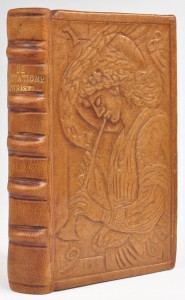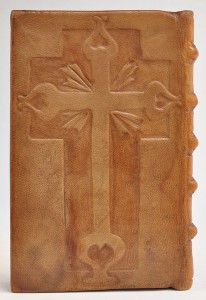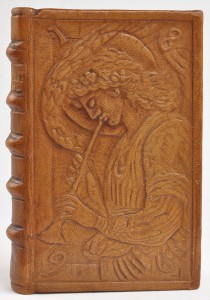 This time last year, I had just returned from a visit to Scandinavia. In my bag was this tiny book, found on the shelves of a Copenhagen bookshop, where it was hidden in the triple-shelved books of the theology section, wedged beside the water pipes. I had recognised the binding as being in the style of the Guild of Women Binders, with its modelled goatskin covers. Though an old pencilled note in the front suggested that the cover depicted Pan with his flute, the image looked more like a Burne-Jones angel to me. The book itself is an unremarkable edition of the Imitatio Christi by Thomas a Kempis. The binding is dated 1896.
This time last year, I had just returned from a visit to Scandinavia. In my bag was this tiny book, found on the shelves of a Copenhagen bookshop, where it was hidden in the triple-shelved books of the theology section, wedged beside the water pipes. I had recognised the binding as being in the style of the Guild of Women Binders, with its modelled goatskin covers. Though an old pencilled note in the front suggested that the cover depicted Pan with his flute, the image looked more like a Burne-Jones angel to me. The book itself is an unremarkable edition of the Imitatio Christi by Thomas a Kempis. The binding is dated 1896.
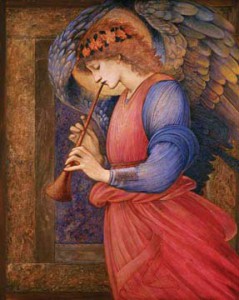 National Museums Liverpool
National Museums Liverpool
How long this angel had been in Denmark I just don’t know. Home in Faversham, a few minutes internet research brought up the source of the image: Edward Burne-Jones’s Angel playing a Flageolet, painted around 1878, now at Sudley House, Liverpool. Of course, it’s one of a veritable host of Burne-Jones angels: they were both his signature and his credo, brought to life in countless paintings, tapestries and stained-glass windows and endlessly reproduced. In 1882 Oscar Wilde recalled Burne-Jones telling him: ‘The more materialistic science becomes, the more angels I shall paint: their wings are my protest in favour of the immortality of the soul’. He seems to have been particularly fond of this musical angel, keeping it in his studio for ten years before parting with it. How did our angel migrate to find itself on a bookbinding? The answer has been provided by Graham Hogg of the National Library of Scotland (who have acquired the book) and is written up on their website:
http://www.nls.uk/collections/rarebooks/acquisitions/singlebook.cfm/idfind/849
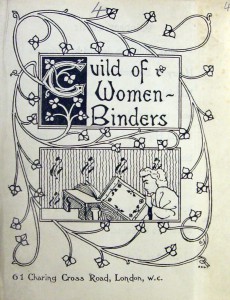
In short, Graham recognised the binding as a product of the late nineteenth-century Edinburgh school of bookbinding founded by Annie McDonald soon known as the Edinburgh Arts and Crafts Club. The work of McDonald and her followers (almost all women) is characterized by these moulded goatskin bindings, where the leather has been worked while wet, with a single tool, pushing and squeezing it into relief, with remarkable effect. When new, their bindings were probably much whiter, only mellowing with age. The Edinburgh group were important, since it was they who inspired the foundation of a larger national organization, The Guild of Women Binders, who made and exhibited many hundreds of innovative book bindings over the coming decades. Their work was very much in tune with the Arts and Crafts Movement, creating objects of beauty and utility which contrasted with increasingly mass produced goods. Women played an important part in this. In mass factory production it was often women who provided cheap deskilled labour of stultifying tedium; one of the aims of The Guild of Women Binders was to allow women to relearn and revive traditional skills in a creative environment.
 The binding has been positively identified as the work of one ‘Miss Maclagan’, probably a pupil of Annie McDonald, who has carefully copied a detail of Burne-Jones’s original, probably from a photographic reproduction. Graham Hogg has also discovered that this very book was exhibited at the 1898 London exhibition of the Guild, where it was item 93 and exhibited as an example of the work of the Edinburgh School.
The binding has been positively identified as the work of one ‘Miss Maclagan’, probably a pupil of Annie McDonald, who has carefully copied a detail of Burne-Jones’s original, probably from a photographic reproduction. Graham Hogg has also discovered that this very book was exhibited at the 1898 London exhibition of the Guild, where it was item 93 and exhibited as an example of the work of the Edinburgh School.
It is one of the great pleasures of bookselling to see books find appropriate homes. There can be no better home for this wonderful binding than the National Library of Scotland.
An angel returns to roost in the city of its birth.
